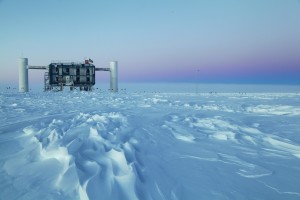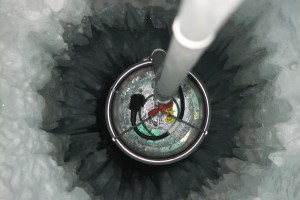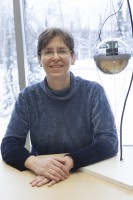UAA researcher involved in global IceCube Collaboration
by Jess |
UAA Associate Professor of Physics Katherine Rawlins, Ph.D., is part of an international research group, the IceCube Collaboration, that has recently discovered evidence of high-energy neutrinos (subatomic particles) of astrophysical origin at a South Pole test site.
Dr. Rawlins is a part of the large experimental group of 250 physicists and engineers from around the world and UAA is one of 41 member institutions spanning 12 countries. The IceCube Collaboration is headquartered at the Wisconsin IceCube Particle Astrophysics Center at the University of Wisconsin-Madison. Their goals: to measure the rate of high-energy neutrinos and identify some of their sources.
Neutrinos are very small, nearly massless particles that come from the sun, radioactive decay, cosmic rays and violent events in the galaxy such as exploding stars.
The IceCube Neutrino Observatory is a particle detector buried in the Antarctic ice made up of 86 strings, each with 60 sensitive light detectors. IceCube gives scientists new ways to study the mysteries of our universe-95 percent of our universe is made up of material we can't see and barely understand; neutrinos may allow for a better understanding of dark matter and dark energy. Nearly 25 years after the pioneering idea of detecting neutrinos in ice, the IceCube Collaboration announces the observation of 28 very high-energy particle events that constitute the first solid evidence for astrophysical neutrinos from cosmic accelerators.
On UAA's campus, Dr. Rawlins and her undergraduate students are contributing to the group's efforts by using IceCube to study cosmic rays: protons and atomic nuclei which strike the top of Earth's atmosphere. The astrophysical engines, which accelerate cosmic rays to their high energies, may also produce neutrinos, and cosmic ray events in IceCube are a source of background in the search for neutrinos. Dr. Rawlins also spent one year at the South Pole research station as a "winter-over" in 2002.
Read more about Dr. Rawlins' collaboration and their exciting findings in this full press release. IceCube's work is also featured as the cover story of the Nov. 22, 2013, issue of Science magazine.
More information:
Katherine Rawlins Associate Professor, Physics (907) 786-1709, krawlins@uaa.alaska.edu
IceCube Frequently Asked Questions: http://icecube.wisc.edu/about/faq
Multimedia Gallery: http://icecube.wisc.edu/gallery/press
 "UAA researcher involved in global IceCube Collaboration" is licensed under a Creative Commons Attribution-NonCommercial 4.0 International License.
"UAA researcher involved in global IceCube Collaboration" is licensed under a Creative Commons Attribution-NonCommercial 4.0 International License.












